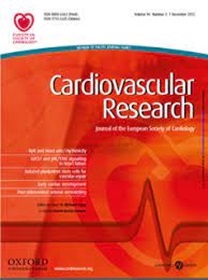胎儿素a通过与血小板上的TLR-4结合而增加非酒精性脂肪性肝病的血栓形成风险
IF 13.3
1区 医学
Q1 CARDIAC & CARDIOVASCULAR SYSTEMS
引用次数: 0
摘要
目的:Fetuin-A是一种肝脏来源的异二聚体血浆糖蛋白,在非酒精性脂肪性肝病(NAFLD)中表现出异常升高。血浆胎儿素a水平与心血管疾病相关的发病率和死亡率密切相关。然而,胎儿素a对nafld相关血小板活化和血栓形成的确切影响仍有待阐明。方法与结果Fetuin-A直接放大激动剂诱导的血小板聚集、致密颗粒三磷酸腺苷释放、p -选择素暴露、整合素α ib β3活化、扩散和凝块收缩。机制上,胎儿素a结合血小板toll样受体-4 (TLR-4),激活TLR-4/MyD88、SFK/ pi3k /AKT、cGMP/PKG和丝裂原活化蛋白激酶信号通路,增强血小板活化。TLR-4特异性拮抗剂TAK-242和TLR-4缺陷小鼠证实了这些作用对TLR-4的依赖性。口服第一哥司他、瑞舒伐他汀或吡格列酮可通过降低胎儿素a水平和降低血小板高反应性来减轻NAFLD小鼠血栓形成。值得注意的是,胎儿素a抑制抗体能有效抑制NAFLD小鼠的血小板活化和血栓形成。该抗体可减轻NAFLD小鼠的血栓栓塞和微血管血栓形成,从而保护肺、心脏和大脑免受加剧的组织梗死。最后,在NAFLD患者中观察到血浆胎蛋白a浓度与血小板聚集呈正相关。结论胎儿素a对NAFLD患者血小板高反应性具有正向调节作用。血浆胎蛋白a通过tlr -4依赖的信号通路,直接放大血小板活化并促进体内血栓形成。首先,他司他、瑞舒伐他汀和吡格列酮通过降低胎儿素a水平来消除这些增强作用。胎儿蛋白a抑制抗体在预防NAFLD血栓并发症方面具有潜在的治疗优势。本文章由计算机程序翻译,如有差异,请以英文原文为准。
Fetuin-A increases thrombosis risk in non-alcoholic fatty liver disease by binding to TLR-4 on platelets
Aims Fetuin-A, a liver-derived heterodimeric plasma glycoprotein, exhibits abnormal elevation in non-alcoholic fatty liver disease (NAFLD). Plasma fetuin-A levels correlate closely with both morbidity and mortality associated with cardiovascular diseases. However, the precise influence of fetuin-A on NAFLD-related platelet activation and thrombosis remains to be elucidated. Methods and results Fetuin-A directly amplified agonist-induced platelet aggregation, dense granule adenosine triphosphate release, P-selectin exposure, integrin αIIbβ3 activation, spreading, and clot retraction. Mechanistically, fetuin-A bound to platelet Toll-like receptor-4 (TLR-4), activating TLR-4/MyD88, SFK/PI3 K/AKT, cGMP/PKG, and mitogen-activated protein kinase signalling pathways to enhance platelet activation. TLR-4 specific antagonist TAK-242 and TLR-4-deficient mice confirmed the TLR-4 dependence of these effects. Oral administration of firsocostat, rosuvastatin, or pioglitazone demonstrated efficacy in alleviating thrombosis formation in NAFLD mice by reducing fetuin-A levels and attenuating platelet hyperreactivity. Notably, the fetuin-A-inhibiting antibody potently suppressed platelet activation and inhibited thrombosis formation in NAFLD mice. Administration of this antibody attenuated thromboembolism and microvascular thrombosis in NAFLD mice, thereby safeguarding the lung, heart, and brain from exacerbated tissue infarcts. Finally, a positive correlation between plasma fetuin-A concentration and platelet aggregation was observed in NAFLD patients. Conclusion Fetuin-A emerges as a positive regulator of platelet hyperreactivity in NAFLD. Acting via TLR-4-dependent signalling pathways, plasma fetuin-A directly amplifies platelet activation and promotes in vivo thrombosis. Firsocostat, rosuvastatin, and pioglitazone abrogate these enhancing effects by reducing fetuin-A levels. The fetuin-A-inhibiting antibody presents potential therapeutic advantages to prevent thrombotic complications in NAFLD.
求助全文
通过发布文献求助,成功后即可免费获取论文全文。
去求助
来源期刊

Cardiovascular Research
医学-心血管系统
CiteScore
21.50
自引率
3.70%
发文量
547
审稿时长
1 months
期刊介绍:
Cardiovascular Research
Journal Overview:
International journal of the European Society of Cardiology
Focuses on basic and translational research in cardiology and cardiovascular biology
Aims to enhance insight into cardiovascular disease mechanisms and innovation prospects
Submission Criteria:
Welcomes papers covering molecular, sub-cellular, cellular, organ, and organism levels
Accepts clinical proof-of-concept and translational studies
Manuscripts expected to provide significant contribution to cardiovascular biology and diseases
 求助内容:
求助内容: 应助结果提醒方式:
应助结果提醒方式:


